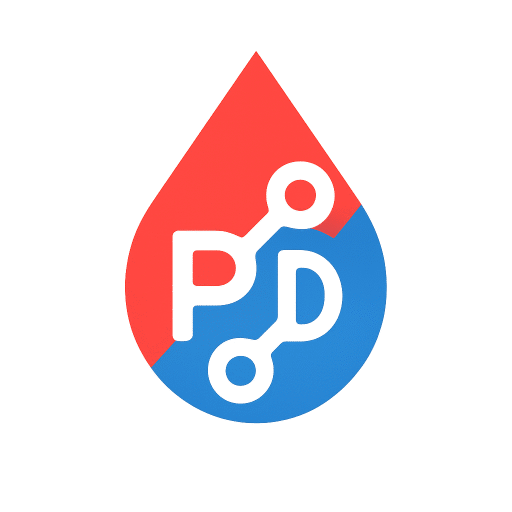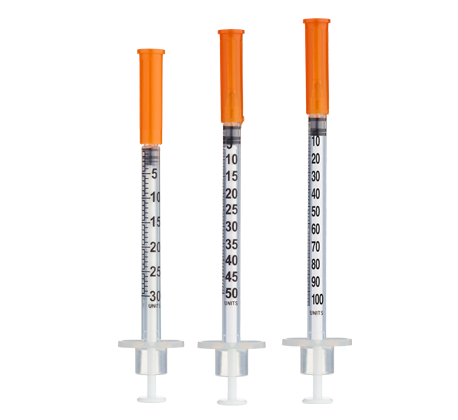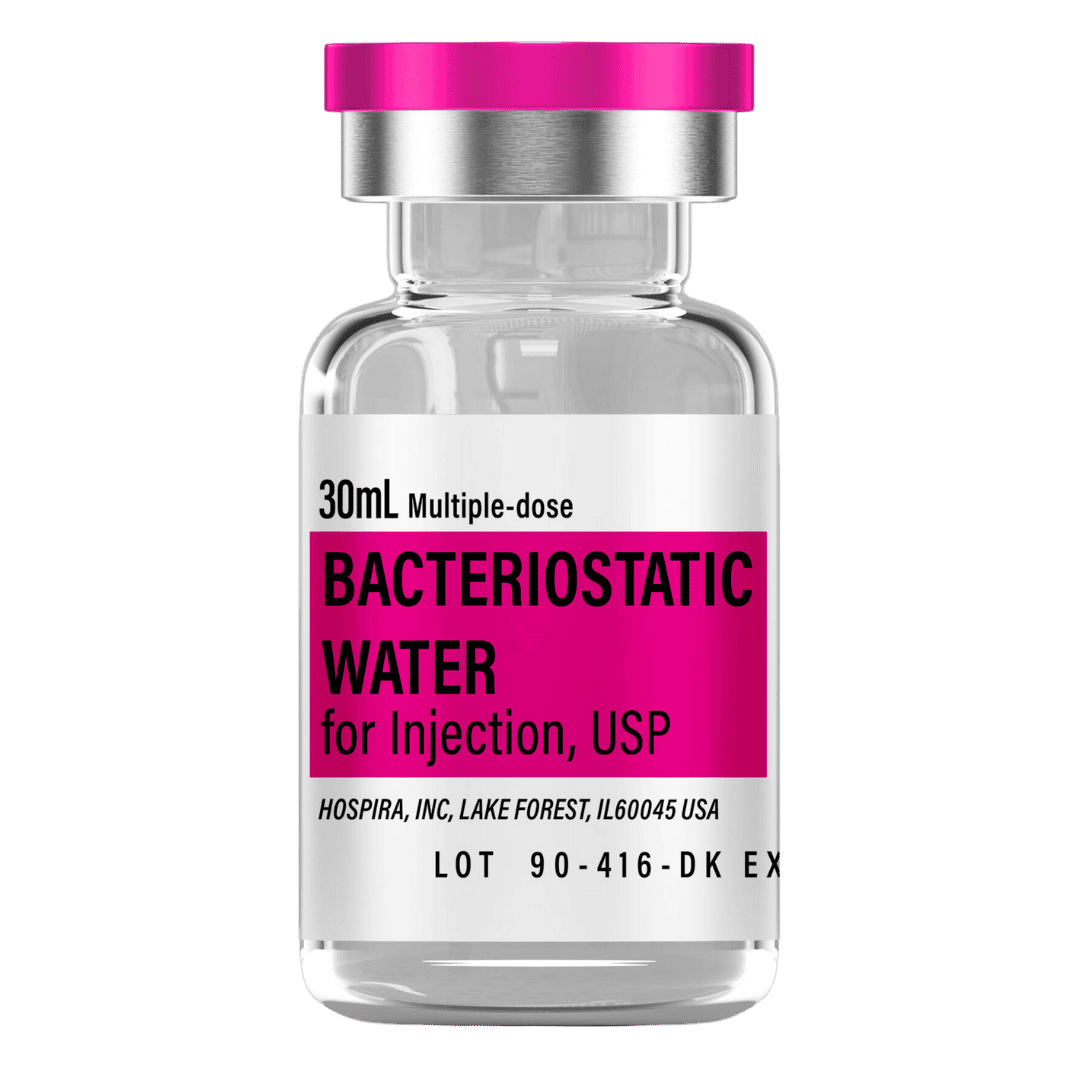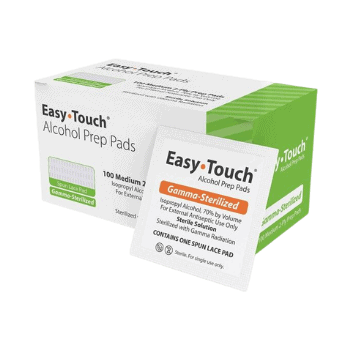Vilon (20 mg Vial) Dosage Protocol
Quickstart Highlights
Vilon (Lys‑Glu; “KE”) is a short bioregulatory dipeptide investigated for immunoregulatory and tissue‑support effects in experimental models and cell systems.[5][6][7] Preclinical studies commonly use a subcutaneous, pulsed regimen (e.g., very low microgram‑level doses delivered daily for 5 days per 4‑week cycle).[1][2]
- Reconstitute (stock): Add 3.0 mL bacteriostatic water → ~6.67 mg/mL stock (≈6,667 mcg/mL); on U‑100 insulin syringes, 1 unit = 0.01 mL ≈ 66.7 mcg from stock.
- Working solution for micro‑dosing: Prepare a sterile 1 mcg/mL working solution (details below). From this dilution, 1 unit = 0.01 mL ≈ 0.01 mcg (10 ng) for accurate 100‑ng measurements.[12][14][15]
- Typical preclinical cycle: 0.1 mcg (100 ng) subcutaneously once daily on Days 1–5 of each 4‑week cycle.[1][2]
- Storage: Lyophilized peptides are commonly stable at about −20 °C (−4 °F); after reconstitution, maintain cold chain (e.g., 2–8 °C (35.6–46.4 °F)) and avoid repeated freeze–thaw cycles.[13]
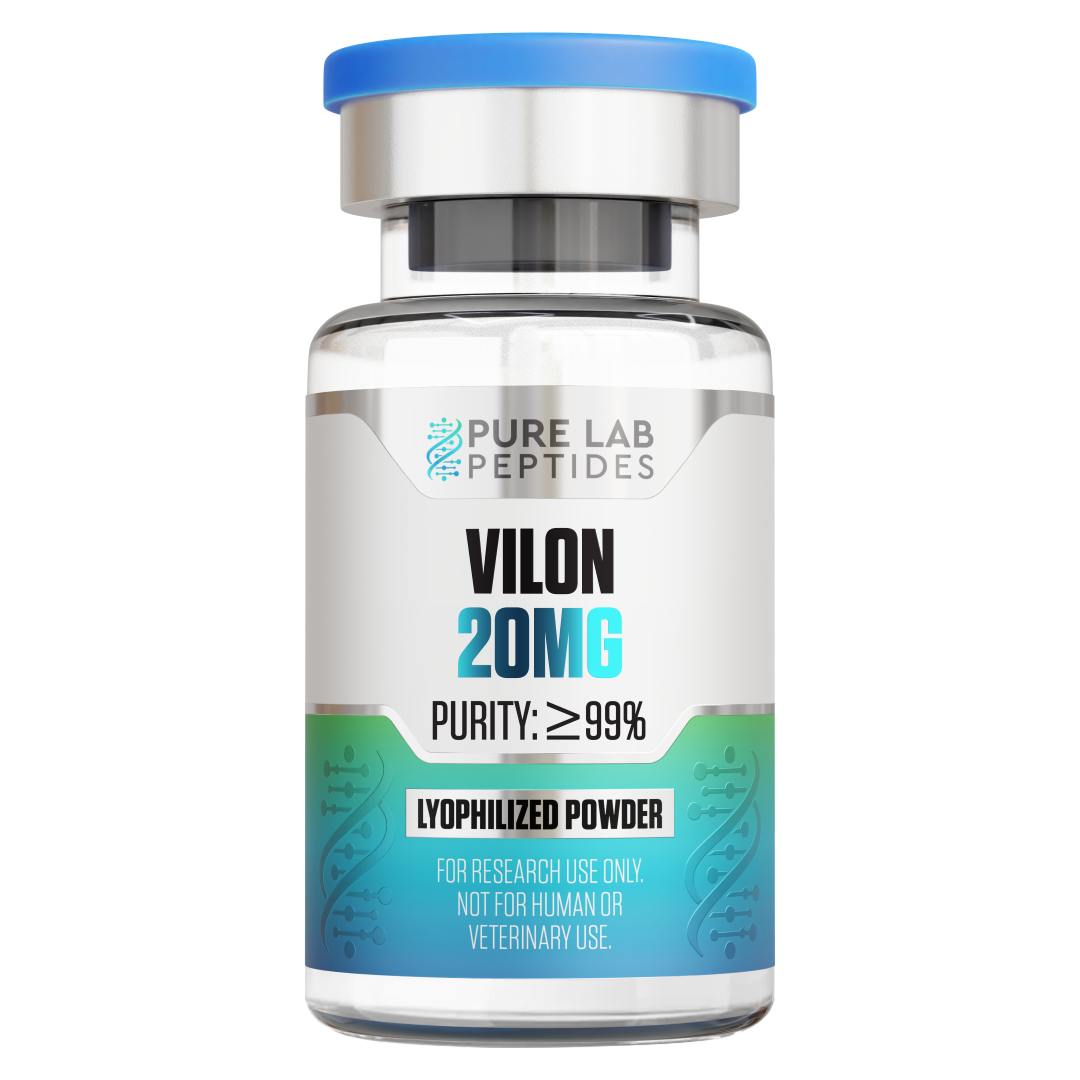
Dosing & Reconstitution Guide
Educational protocol aligned with preclinical literature and standard subcutaneous technique
Standard / Pulsed Approach (Stock 3.0 mL = ~6.67 mg/mL; Working = 1 mcg/mL)
Route: Subcutaneous (SC). Frequency: Once daily on Days 1–5 of each 4‑week cycle (preclinical convention).[1][9][10]
| Week / Phase | Per‑Administration Dose | Units (per injection) (mL) |
|---|---|---|
| Week 1 (Cycle 1: Days 1–5) | 0.1 mcg (0.0001 mg) | 10 units (0.10 mL) |
| Week 5 (Cycle 2: Days 29–33) | 0.1 mcg (0.0001 mg) | 10 units (0.10 mL) |
| Week 9 (Cycle 3: Days 57–61) | 0.1 mcg (0.0001 mg) | 10 units (0.10 mL) |
| Week 13 (Cycle 4: Days 85–89) | 0.1 mcg (0.0001 mg) | 10 units (0.10 mL) |
Units above are calculated from a 1 mcg/mL working solution. At the stock concentration (~6,667 mcg/mL), 1 unit ≈ 66.7 mcg and microgram‑level dosing is not directly measurable on standard U‑100 syringes; therefore, prepare a sterile working dilution for accurate micro‑dosing.[12][14][15]
Low‑unit precision note: For ≤10‑unit (≤0.10 mL) administrations, consider 30‑ or 50‑unit insulin syringes for improved readability.[12]
Reconstitution & Working‑Solution Steps
- Reconstitute the vial: Using aseptic technique, draw 3.0 mL bacteriostatic water and add slowly down the vial wall; gently swirl to dissolve. This yields ~6.67 mg/mL stock.[11][14][15]
- Prepare sterile working solution (target 1 mcg/mL): Perform sterile serial dilutions (e.g., first to ~6.67 mcg/mL, then to 1 mcg/mL) in a separate sterile vial to enable 0.1 mcg dosing at 10 units per injection. Label both concentration and date.[12][14][15]
- Storage: Keep lyophilized peptide near −20 °C (−4 °F) and reconstituted/working solutions refrigerated at 2–8 °C (35.6–46.4 °F); avoid repeated freeze–thaw cycles.[13]
- Administration technique (SC): Clean stopper and skin; pinch a skinfold and inject into subcutaneous tissue at 45°–90°. Aspiration is not necessary for SC injections.[9][10][11]
Citation note on schedule: The pulsed five‑day SC schedule at very low microgram doses is drawn from preclinical mouse studies and is presented here for therapeutic educational context, not as clinical guidance.[1][2]
Supplies Needed
Plan based on 2–4 monthly cycles (5 injection days per 4‑week cycle).
-
Peptide Vials (Vilon, 20 mg each):
- 8 weeks (2 cycles): 1 vial (20,000 mcg stock far exceeds microgram requirements)
- 12 weeks (3 cycles): 1 vial
- 16 weeks (4 cycles): 1 vial
-
Insulin Syringes (U‑100):
- Per cycle: 5 syringes (1/day)
- 8 weeks: 10 syringes
- 12 weeks: 15 syringes
- 16 weeks: 20 syringes
-
Bacteriostatic Water (10 mL bottles): Use ~3.0 mL per vial for stock; additional sterile diluent required for working solutions.
- All above cycles (1 vial): 3.0 mL for stock (plus sterile diluent for serial dilutions)
-
Alcohol Swabs: One for vial stopper + one for injection site each injection day.
- Per cycle: 10 swabs (2/day)
- 8 weeks: 20 swabs
- 12 weeks: 30 swabs
- 16 weeks: 40 swabs
Protocol Overview
Summary of a microgram‑level, SC pulsed regimen used in preclinical studies.
- Goal: Educational overview of methods used to explore immune modulation and tissue‑support effects of Lys‑Glu in models and cells.[5][6]
- Schedule: 0.1 mcg once daily on Days 1–5 of each 4‑week cycle; repeat for 2–4 cycles as needed for study design.[1][2]
- Dose scale: Microgram‑level per injection (100 ng) in published animal work; human dosing has not been established by high‑quality trials.[1][3]
- Reconstitution: 3.0 mL per 20 mg vial (~6.67 mg/mL stock) plus sterile serial dilutions to a 1 mcg/mL working solution for accurate measurements.[12][14]
- Storage: −20 °C (−4 °F) lyophilized; 2–8 °C (35.6–46.4 °F) after reconstitution; avoid freeze–thaw cycles.[13]
Dosing Protocol
Literature‑based pulsed approach with unit conversions.
- Cycle design: Days 1–5 each 4‑week cycle at 0.1 mcg per day (SC).[1]
- Units from working solution: 1 mcg/mL → 0.01 mcg per unit → 10 units (0.10 mL) per 0.1 mcg dose.
- Technique: 45–90° insertion into subcutaneous tissue; no aspiration; rotate sites.[9][10][11]
- Compounding hygiene: Use sterile technique and clearly labeled concentrations when preparing working dilutions.[14][15]
Storage Instructions
Preserve peptide integrity with conservative handling.
Important Notes
Practical considerations for consistency and safety.
How This Works
Short peptides can regulate gene expression programs relevant to immune and tissue homeostasis; Lys‑Glu (Vilon) specifically has been shown to influence cytokine signaling (e.g., IL‑2) and modulate inflammatory/proliferative pathways in cell models.[5][6][7] In aged mice, chronic subcutaneous Vilon in low microgram doses over months has been reported to improve certain functional measures and survival, though results vary by model and design.[1][3]
Potential Benefits & Side Effects
Observations from preclinical and cell literature.
- Immune‑modulating and tissue‑support signals (e.g., IL‑2 transcription effects; regulation of inflammatory pathways in THP‑1 cells).[6][7]
- In certain rodent models, long‑term SC Vilon has been associated with improved functional metrics and lifespan signals; findings are model‑dependent and not directly generalizable to humans.[1][3]
- Important caution: In a HER‑2/neu transgenic breast cancer model, Vilon exposure was associated with increased mammary tumor development parameters compared with controls, underscoring the need for careful context and risk assessment in oncology‑related settings.[4]
- SC injections may cause mild local reactions (redness, itch, tenderness); rotate sites and use proper technique.[9][11]
Lifestyle Factors
Complementary strategies for consistent protocols.
- Follow a balanced, protein‑forward diet tailored to energy needs.
- Combine resistance and aerobic activity for overall health.
- Prioritize sleep and stress management to support adherence.
Injection Technique
General subcutaneous guidance from recognized clinical resources.[9][10][11]
Recommended Source
We recommend Pure Lab Peptides for Vilon (20 mg).
Why Pure Lab Peptides?
- High‑purity, third‑party documentation with batch COAs.
- Consistent handling and documentation practices.
- Reliable fulfillment to maintain cold‑chain integrity.
Product ID: 14287
Important Note
This content is intended for therapeutic educational purposes only and does not constitute medical advice, diagnosis, or treatment.
References
-
Bull Exp Biol Med (2000)
— Effect of Vilon (Lys‑Glu) on biological age and lifespan in mice; SC dosing schedule described -
Bull Exp Biol Med (PDF, 2000)
— Full article text shows 0.1 mcg SC daily ×5 days monthly in mice -
Dokl Biol Sci (2000)
— Synthetic dipeptide Vilon inhibits spontaneous tumors and increases lifespan in mice -
Int J Cancer (2002)
— HER‑2/neu transgenic study; Vilon exposure associated with increased mammary tumor development vs. controls -
Peptide Regulation of Gene Expression — Systematic Review (2021, PMC)
— Overview of short peptides regulating gene expression across systems -
Peptides Regulating Proliferative/Inflammatory Pathways in THP‑1 (2022, PMC)
— Includes Vilon in human monocytic cell model work -
Dokl Biol Sci (2000)
— Lys‑Glu stimulates interleukin‑2 gene expression in mouse spleen lymphocytes (in vitro) -
Bull Exp Biol Med (2005)
— SC Vilon reduced TGF‑β1 and microvascular permeability in rat chronic renal failure model -
CDC — Vaccine Administration Best Practices (2024)
— SC route angle/site guidance -
CDC — Subcutaneous Injection Job Aid (2024, PDF)
— 45° angle; aspiration not required -
NCBI Bookshelf — Best Practices for Injection
— Asepsis, preparation, and administration principles -
Subcutaneous Injection of Drugs — Review (2019, PMC)
— Pharmacologic and practical considerations for SC dosing -
Strategies to Overcome Protein/Peptide Instability (2023, PMC)
— Lyophilized peptide stability at ~−20 °C and avoiding freeze–thaw -
ASHP Video Guide to USP <797> (2009, PMC)
— Sterile compounding fundamentals for aseptic preparation -
Guidelines for Safe Preparation of Sterile Compounds (2013, PMC)
— Practical guidance aligned with USP <797> for sterile dilutions -
Pure Lab Peptides
— Vilon (20 mg) product page
